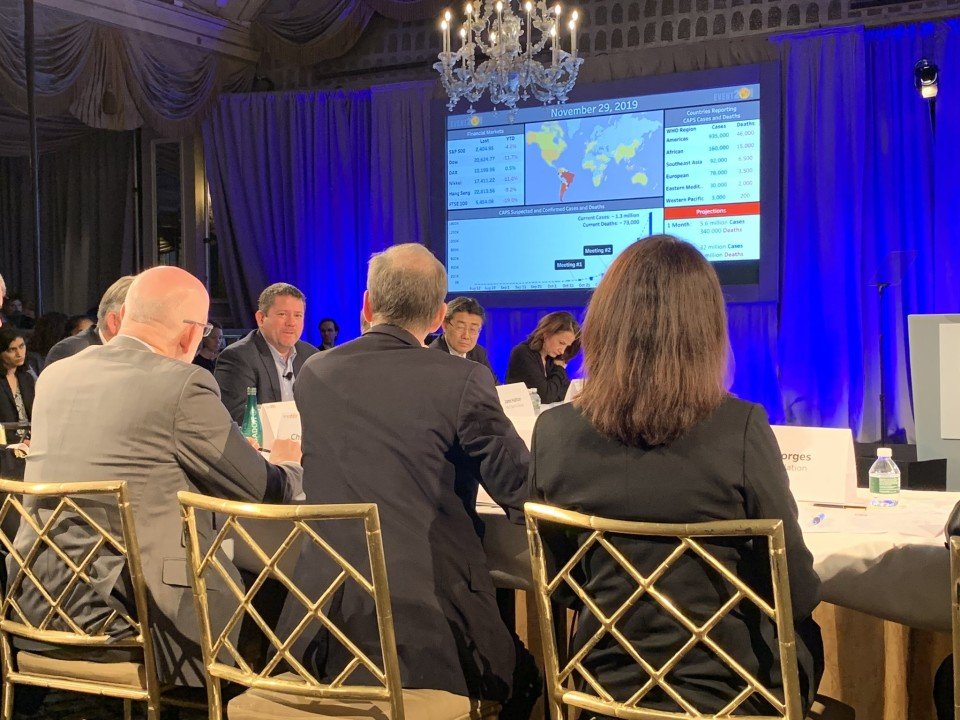
In the first minute, Event 201 exposed a huge gap in the world’s ability to respond to a fast-moving disease outbreak.
Event 201 was a half-day pandemic simulation hosted by Johns Hopkins University, the World Economic Forum, and the Bill & Melinda Gates Foundation on Friday, October 18 in New York.
The title refers to the fact that there are currently 200 outbreaks every year. With climate change, urbanization, and deforestation, this number is expected to grow, and we never know when “Event 201” might occur, and if it will be a highly contagious airborne pathogen.
The simulation began with the news that a new disease had been identified and was quickly spreading to multiple countries, therefore the World Economic Forum was convening the “Pandemic Emergency Board.” So a challenge right from the start – there is no standing Pandemic Emergency Board, or anything else like it, that brings governments, the private sector, non-profits and the United Nations together to rapidly assess fast-moving outbreaks and discuss strategies to limit catastrophic impacts on human life and livelihoods.
Within the first 30 minutes of the simulation, more gaps became apparent: How do you ethically distribute medical supplies that are in short supply? What financing mechanism in place to ensure a global supply chain? How do you incentivize manufacturers to increase production of those critical supplies? Who is the “honest broker” responsible for leading those conversations?
These gaps were not a limitation of the simulation – it was extremely well-done – but rather a failure of today’s global policy infrastructure to adapt to the realities of a highly globalized world where a disease can travel around the world via a single airplane ride.
The default response among some leaders is to close borders, or to impose sanctions on affected countries. However, public health experts remind us that closing physical borders does nothing to protect against a disease with airborne transmission. Nor is the global economy protected by national borders. To take just one example, the hotel industry comprises 5 percent of the world’s Gross Domestic Product. Imagine how the industry would be affected by an outbreak – not only would the hotels and guests be impacted, but it would cause a massive ripple effect to their employees, suppliers and others.
Over the course of the three-hour simulation, additional gaps in the world’s ability to respond to a massive pandemic continued to become apparent: How do we convince leaders to keep borders open? Who is best positioned to communicate to the public accurate health information? What should be done to support businesses affected by the outbreak?
However, these questions are not new. Report after report, panel after panel, commission after commission, have raised these same questions and have proposed answers for how the world might prepare for a major outbreak before it happens.
These reports, panels, and commissions tend to recommend a neutral, non-governmental body be established for the express purpose of ensuring we have systems, protocols, and yes, answers, to these questions ready when we need them.
Public health experts refer to the attention that is paid to outbreaks as a cycle of “panic and neglect. As one of the business representatives participating in Event 201 said: “Yes, we all know we have to prepare for the future, but we have our day jobs that need to get done today.”
We can’t afford to wait for the next time the pendulum swings to panic. We need to make sure it is someone’s job – today, during “peace time” – to get ahead of these questions, and make sure we have the answers ready when we need them.
 Your Vision
Your Vision Our Platform
Our Platform Real impact
Real impactPanorama Global is a member of The Panorama Group.
Privacy Policy © 2025 Panorama Global. All rights reserved.
